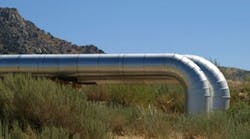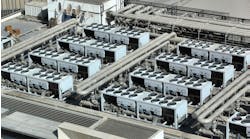Meet The District Energy Loop: A Larger-Scale Geothermal Heat Pump
There are many ways to design geothermal energy systems, but for commercial buildings, the options typically fall into two categories.
- Ground Source Heat Pump: Small loops in the ground serve as a more efficient heat source/sink for a building’s HVAC system. The loops can be configured as a horizontal “slinky” or a vertical well. Because the ground maintains a more constant temperature during the summer and winter, it’s easier to transfer heat to and from it; for example, in the summer, an air-to-air heat exchanger has a hard time rejecting heat when the air outside is 100 degrees F. A ground source system can use the ground temperature (which is typically more like 60 degrees F.) to cool a building. Conversely, in the winter, a ground source heat system can pull heat into a building much easier with a 60-degree ground temperature than it can with 30-degree outside air.
- Geothermal Electric Generation Stations: A geological “hot spot” is used to turn water into steam and then the steam powers a turbine generator to make electric power.
However, in this article I would like to describe what I would call a geothermal district energy loop, which is a much larger scale of the traditional ground source heat pump (GSHP) and offers several key advantages.
How It Works
The basic idea is to put a very large loop (water in pipe) in the ground under or near buildings. Just like a GSHP, this larger district loop will exchange energy to and from the ground depending on winter or summer, while also acting like an “energy pipeline” or “energy highway” to exchange energy between multiple buildings. A larger loop provides less temperature fluctuation and serves as a thermal mass that can be used as a “shock absorber” of sorts that provides more stability to the entire system.
In addition, like a typical variable refrigerant flow system, the loop can transfer heat to and from rooms within the building. For example, if you have a data center that generates waste heat year-round, instead of throwing this heat away to an outside air condenser, you can reuse that heat in another part of the building or make domestic hot water.
Another advantage of having the heat source/sink underground is that it is less visible and preserves the aesthetics of landscaping around your building, as well as eliminating condenser noise. In addition, underground systems provide greater resilience against storms, vandalism and other threats that occur on the surface.
I see this design approach as a foundation for buildings of the future, and these simple systems can be integrated with other renewable systems, which can make your building or campus more environmentally sustainable.
Case Study
This large loop design approach was applied to Colorado Mesa University in Grand Junction, CO. Over a decade ago, the geothermal system started with one large pipe (18 inches in diameter) and a campus loop that connected five buildings and a dormitory. They were able to store energy in the ground during the day and then recover that energy at night to keep the buildings from freezing.
The system was very cost-effective, so the university decided to expand it as they expanded their campus. Now, the geothermal system encompasses 16 buildings and has about 3 miles of loop. They also added micro loops within buildings that can be operated at different temperatures (some around 80 degrees F., some at 50) to provide a variety of solutions to each of the building’s zones. Much of these enhancements are enabled by advancements in refrigerants and heat transfer technologies. However, the basic concept is still the same – using the earth to heat and cool, and also exchanging heat between buildings and zones rather than throwing away energy into the atmosphere.
The results speak for themselves. Although the university has expanded its footprint by 50 percent (from 800,000 square feet to 1.2 million), managers have been able to keep their power load flat at less than 4 MW demand from the local electric utility, which also has a demand savings impact to the bottom line. From a fossil fuel perspective, since going with geothermal six years ago, they have not had to fire a boiler to heat the buildings. This is quite remarkable because this particular location has very cold winter seasons.
In 2016, the university reported that their 4,400-ton system was saving over $500,000 per year on energy and 14 million gallons of water per year, mostly due to not throwing away energy and water by operating cooling towers.
Conclusion
I foresee geothermal district energy loops becoming more popular and enabling facilities professionals to capture even greater energy savings than the university in this case study. Consider the net energy going into a building to heat and cool all year long. When you can avoid throwing some of that energy away (for example, by taking heat from the data center and providing free hot water), your net COP can be two to three times greater than conventional isolated systems.
Have you worked on a similar project or integrated one of these systems with solar thermal or CHP? Write to me at [email protected]. Understanding how to sustainably use the earth via geothermal exchange is part of an energy manager’s future.
I also want to thank two gentlemen who have been involved in geothermal for decades and brought to my attention this great case study from Colorado. Garen Ewbank can be reached at [email protected]. Cary Smith can be reached at [email protected]m.
---------------------------------------------------------


